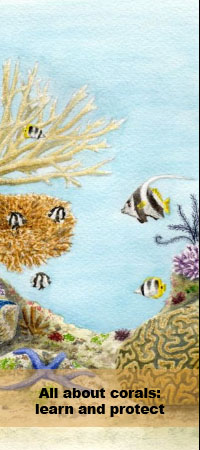|
Coral reefs are found worldwide and occupy around 0.1% (approximately 600,000 km2) earth’s surface. Although typically associated with warm, clear tropical waters, some coral species tolerate lower ocean temperatures. These corals are known as cold-water or deep-water corals.
Tropical corals
In the tropics, corals are generally found in shallow waters (measuring less than 70 metres in depth) where the ocean temperatures range from 23-29°C. Many species of reef-building corals host symbiont zooxanthelle that provide polyps with nutrients that may be used in coral growth (skeleton secretion of reproduction). As the zooxanthelle produces nutrients through photosynthesis, coral reefs are usually located in clear, low sediment water environments which allow the penetration of sunlight. Coral polyps are also sensitive to water salinity and grow best in conditions of around 32-42 parts per thousand, for this reason corals tend not survive near a river mouth where fresh waters is discharged.
Tropical corals
Unlike tropical corals, cold-water corals can be found in ocean temperatures as low as 4°C. They often located along continental shelves, slopes canyons and seamounts where depths range from about 50 metres below the sea surface to the abyss (2,000 m). There is little to no light available at these depths so zooxanthelle cannot be hosted within the tissue of coral-water corals, therefore, they are suspension feeders. Few reef-building species around found in cold water environments and hard cold-water corals are generally solitar. Although some species do form colonies, they do not create large reef frameworks that resemble those found in the tropics. Instead, cold-water corals form patches, mounds and branches which are still referred to as reefs. The global distribution of these cold-water reefs is shown on the map below.
The largest cold-water coral reef is believed to be Rot Reef (100 km2) discovered in 2002 in northern Norway and the largest tropical reef is the Great Barrier Reef (Australia) measuring over 30,000 km2.
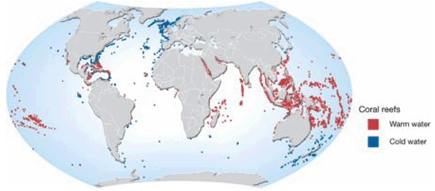
The status of coral reefs
Hard coral growth forms
The global status of coral reefs has become a cause for concern as scientists have reported widespread loss of live reef cover as well as a decline in regional reef conditions. In the Caribbean, combined analysis of coral survey data spanning 25 years has revealed that coral reefs are declining at a rate of 5.5% - 9.2% per year. In the Indo-Pacific region, a 2% loss of coral reefs per year has been estimated.
Today, 33% of coral species are listed on the on the International Union for Conservation of Nature (IUCN) Red List of endangered species. This list classifies the extinction risk of species based on criteria such as population size reduction and geographic range information. This list forms an objective framework which is used to set priority measures for biodiversity conservation. The categories of this framework range from Least Concern (LC) where there is little possibility of the species becoming extinct to Critically Endangered (CR) where there is a high risk of the species becoming extinct. Assessing actual population trends of individual species of coral can be extremely difficult given their global distribution. Few long-term species-specific datasets are available today and where studies exist they are generally confined to a geographic region or reef system. Therefore, scientists have used widely cited and accepted estimates of reef loss to determine the extinction risk of reef-building coral species in accordance with the IUCN Red List criteria. In terms of classification, there is only sufficient data to determine the extinction risk for 704 of the 845 known zooxanthelle-hosting corals (including hard, soft and hydrocorals). The results of this study indicate that of those 704 corals, 231 (32.8%) species are listed in the threatened categories (Vulnerable (VU), Endangered (EN) and Critically Endangered (CR)) while 407 are listed in the threatened (VU, VN, CR) and Near Threatened (NT) categories combined (Carpenter et al 2008). The species that were identified to be most at risk, with approximately 50% or more species being listed in a threatened category, belong to Euphylliidae, Dendrophylliidae and Acroporidae families. In 1998, 671 of the 704 species (identified above) would have been listed as Least Concern, 20 as Near Threatened, and only 13 in the threatened categories, indicating a dramatic increase in the risk of extinction of corals.
When the figures obtained in this study were considered as percentage of the total species found in an area, regional differences between the levels of risk of species extinction were identified. The greatest proportion of the coral species listed in the threatened and Near Threatened categories found the Indo-Pacific Coral Triangle region while coral in the oceanic Pacific islands have the lowest proportion of threatened species of corals.
|
|
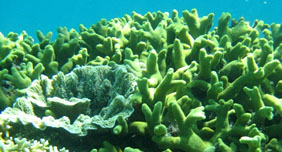
Tropical corals found in shallow water display high diversity of species. © Pierre Fidenci
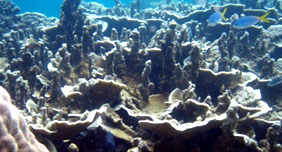
Coral reefs are usually located in clear, low sediment water environment. © Endangered Species International
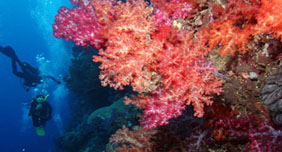
Unlike tropical corals, cold-water corals can be found in ocean temperatures as low as 4°C © Paddy Ryan
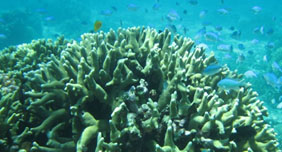
Corals polyps are sensitive to water salinity and grow best in conditions of around 32-42 parts per thousand. © Pierre Fidenci
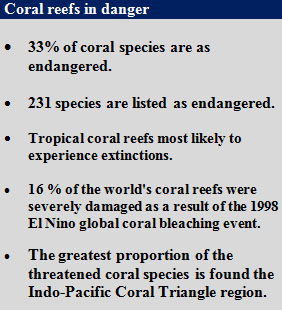
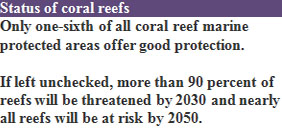
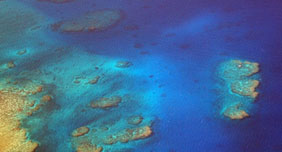
© Paddy Ryan
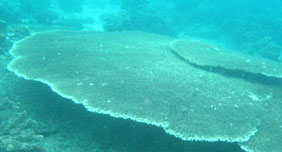
A large Acropora sp. threatened by dynamite fishing in the Coral Triangle. © Pierre Fidenci
|

